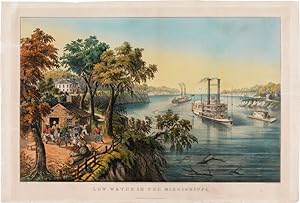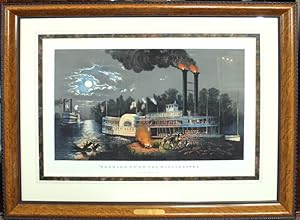Palmer and Flora (15 results)
Product Type
- All Product Types
- Books (14)
- Magazines & Periodicals (1)
- Comics
- Sheet Music
- Art, Prints & Posters
- Photographs
- Maps
-
Manuscripts &
Paper Collectibles
Condition
- All Conditions
- New
- Used
Binding
Collectible Attributes
- First Edition (9)
- Signed (1)
- Dust Jacket (4)
- Seller-Supplied Images (8)
- Not Printed On Demand
Seller Location
Seller Rating
-
FLORA TRISTAN'S LONDON JOURNAL 1840 : A Survey of London Life in the 1830s : Translation of Promenades dans Londres
Published by George Prior, GB, 1980
ISBN 10: 0860434044ISBN 13: 9780860434047
Seller: Richard Sylvanus Williams (Est 1976), WINTERTON, United Kingdom
Book First Edition
Hardback. Condition: VG+. Dust Jacket Condition: VG+ DW. 1st Thus. Mid-brown cloth, gilt. Book is in almost fine condition BUT top of spine lightly bumped and small dust mark to top text edge next to spine. Shaded linear marks to front cover only visible when held to the light. Dustwrapper/dustjacket is in very good plus condition with very minor signs of wear and/or age. Top of spine bumped, Minor score marks to back cover.
-
Hildegarde Withers Makes the Scene
Published by Random House, 1969
Seller: Cape Breton Regional Library, Sydney, NS, Canada
Book
Hardcover. Condition: Fair. Dust Jacket Condition: Yes, with plastic cover. Stated first printing. Spine has a lean. Binding is intact but is cracked at page 1 and the hinge is partially visible. Contents are generally clean throughout with some finger soiling and thumbing to outer page edges. Top edges of pages are dusty. Dust jacket is in fair shape. Former library book with usual library stamps, tape stains, stickers and markings.
-
Hildegarde Withers Makes The Scene
Published by Random House, 1969
Seller: Bookworks, Chicago, IL, U.S.A.
Book First Edition
Hardcover. Condition: Fine. Dust Jacket Condition: Near Fine. 1st Edition. First Edition, First Printing, 1969. Subtitled "Hildegarde finds murder among the hippies". Fine contents and binding; clean and tightly bound. Very slight aging to pages but appears unread. The unclipped dust jacket shows minor aging to the spine, still almost fine. A nice copy.
-
Hildegarde Withers Makes The Scene
Published by Random House, New York, 1969,, 1969
Seller: Ocean Tango Books, North Hollywood, CA, U.S.A.
First Edition
Hardcover. Condition: Very Good. Dust Jacket Condition: Very Good. 1st Edition. First edition San Francisco Hippie Mystery very good condition hard cover in a very good dust jacket clean pages gently read.
-
The New York Times Magazine, January (Jan.) 30, 1972 - Homecoming in Bangladesh
Published by The New York Times & Arno Press, New York, 1972
Magazine / Periodical First Edition
Single Issue Magazine. Condition: Good. Illustrated by Shay, Arthur (cover); Laure, Jason; Avery, John; Shay,Arthur; Kennerley, Dave; Aller, Bill; Manning, Jack (illustrator). First Edition. 80 pages. Features: Before and after photos of former campus radical David Sundance; Homecoming in Bangladesh - Nine million Bengali Hindus fled to India during last year's terror; It's Easier to Convict TV Thieves than Rapists in New York; Is Inflation a Psychosomatic Illness? - with photos of C. Jackson Grayson Jr.; Metamorphosis of the Campus Radical - article with photos of Bo Beller, Jim Sutton, Ted Politis and Sue Ross; Adorable little girl and Teddy Bear in Little Miss Teenform ad; Bold two-page ad for Paradise Island in the Caribbean; A Doctor Explains How He Allows Parents to make Life-or-Death Decisions about the health of their children; Antiquarian home of Mr. & Mrs. James Tyson; Fashion photos of Charlotte Ford (of the motor car company); Many gorgeous color fashion ads; and more. Average external wear with small chip from upper corner of front cover. A worthy vintage copy.; Folio - over 12" - 15" tall; The New York Times Magazine, January (Jan.) 30, 1972 - Homecoming in Bangladesh campus radical David Sundance; Homecoming in Bangladesh - Nine million Bengali Hindus fled to India during last year's terror; It's Easier to Convict TV Thieves than Rapist.
-
Across the Continent; "Westward the Course of Empire Takes its Way"
Published by Currier and Ives, New York, 1868
Seller: Ground Zero Books, Ltd., Silver Spring, MD, U.S.A.
Condition: Good. Size is small folio, approximately 12 inches by 10 inches. There is a mat, approximately 14.5 inches by 12.5, with a width of 1.5 inches at the two sides and top, and a width of 2 inches at the bottom. The print has been affixed with masking tape to the mat, which is in front of the image. Frances "Fanny" Flora Bond, later Palmer, was born inLeicester, England, on July 24, 1812. Palmer specialized inlandscapeand genre prints. Among her subjects were rural farm scenes, famous American ships and architecture, hunters, andWesternlandscapes. Though her work was mainly directed by the type of prints that Currier and Ives wanted to sell or determined by preexisting prints, her few original pieces received praise for their compositional fluidity and technical skill. Frances Flora Bond Palmer, was the first woman in the United States to make her living as a full-time artist. She was one of America's most prolific print artists of the 19th century. This particular work of hers, "Across the continent- Westward the course of Empire takes its way", is probably her best and most renowned work. A New York to San Francisco train leaving a (Western) frontier new born town, two horse-riding indians being spectators in the changing of the times in this scene, the vast uncovered and virgin territory that lies ahead, the loggers in the forest, the Public School, the telegraph posts, a convoy of covered wagons in the distance and so on make this an amazing testimony of that time when the American nation was recovering from an internal civil war and the colonizing of the West was at it's peak. Currier and Iveswas a successful Americanprintmakingfirm based in New York City from 1835 to 1907 headed first byNathaniel Currier, and later jointly with his partnerJames Merritt Ives. The prolific firm produced prints from paintings by fine artists as black and whitelithographsthat were hand colored. Lithographic prints could be reproduced quickly and purchased inexpensively, and the firm called itself "the Grand Central Depot for Cheap and Popular Prints" and advertised its lithographs as "colored engravings for the people".The firm adopted the name "Currier and Ives" in 1857. Currier In 1835, created a lithograph that illustrated a fire sweeping through New York City's business district. The print of the Merchant's Exchange sold thousands of copies in four days. Currier realized that there was a market for current news, so he turned out several more disaster prints and other inexpensive lithographs that illustrated local and national events. The name Currier & Ives first appeared in 1857, when Currier invited the company's bookkeeper and accountant James Merritt Ives (1824-95) to become his partner. The firm Currier and Ives described itself as "Publishers of Cheap and Popular Prints". At least 7,500 lithographs were published in the firm's 72 years of operation. Artists produced two to three new images every week for 64 years (1834-1895),producing more than a million prints by hand-coloredlithography. For the original drawings, Currier & Ives employed or used the work of many celebrated artists of the day. Skilled artist lithographers such as John Cameron, Fanny Palmer, and others became known for their work and signed important pieces. Artists such as A. F. Tait became famous when their paintings were reproduced as lithographs. Currier and Ives was the most prolific and successful company of lithographers in the U.S. Its lithographs represented every phase of American life. Currier & Ives prints were among the household decorations considered appropriate for a proper home byCatharine Esther BeecherandHarriet Beecher Stowe, authors ofAmerican Woman's Home(1869). The original lithographs shared similar characteristics in inking and paper, and adhered to folio sizes. Their measurement did not include the title or borders. Currier used a cotton based, medium to heavy weight paper depending on the folio size for his prints until the late 1860s. From about 1870, Currier & Ives used paper mixed with a small amount of wood pulp." In addition, Currier's inking process resembled a mixture of elongated splotches and dashes of ink with a few spots, a characteristic that modern reproductions would not possess. Framed, but removed from a rather pedestrian frame for inspection. Sold and shipped flat, unframed--but current frame can be included Believed to be an original print, not a 1940s Andres Inc. reproductions which were large folio size.
-
View of Astoria, L.I. from the New York Side
Published by Currier & Ives, 152 Nassau St., New York, 1862
Seller: Antipodean Books, Maps & Prints, ABAA, Garrison, NY, U.S.A.
First Edition
Print. Condition: A pleasant copy. First printing. Attractive scene, the fore shore a rocky beach with a rowboat. Looking across the water, the steamboat the "Sylvan Grove" is visible as well as many masted ships. Large homes are visible on the opposite shore. Fanny Palmer designed over 200 prints of American life and captured the nation's imagination. Today, Palmer's scenes of country living, outdoor recreation, national progress, and newsworthy events continue to rank among the most popular lithographs produced by Currier & Ives. Lithograph, original color, couple of foxing spots in the sky and the top margin of the print. Somewhat tanned overall, "F.F. Palmer, del." printed in lower right corner.
-
The Old Oaken Bucket
Published by Currier & Ives, New York, 1864
Seller: The First Edition Rare Books, LLC, Cincinnati, OH, U.S.A.
First Edition
Lithograph. Condition: Near fine. From Currier & Ives, The Old Oaken Bucket by Frances Flora Palmer, published in 1864. (illustrator). Lithograph. Lithographed and published by Currier & Ives at 152 Nassau St., New York. Short closed tear along top edge, archival tissue repair. Printed on wove paper. Includes 2 stanzas and 4 lines of verse by Samuel T. Woodworth. Original artwork by Frances Flora Bond Palmer. Image measures 15 15/16 x 23 3/8. (Conningham 4576) In wood frame, not examined outside of frame. An attractive work. "When Frances "Fanny" Flora Bond Palmer moved to New York from England in 1844 she was thirty-two and an accomplished artist and printmaker. Initially, Fanny and her husband Seymour operated a small print-shop in lower Manhattan, similar to one they had run in Leicester (United Kingdom). In 1849, the couple moved to Brooklyn after the business closed. Nathaniel Currier recognized Palmer's talent and began to buy her drawings to use as print designs. After Currier & Ives was established in 1857 she became a staff artist. As a designer able to transfer images to lithographic stones for printing, Palmer produced more than 200 prints for the firm and today is regarded as a leading woman lithographer of the period." - Met Museum, 2023. Currier and Ives was a prominent American printmaking firm that operated from 1834 to 1907. They are best known for their lithographs, which depicted a wide range of subjects, including landscapes, historical scenes, portraits, and everyday life in 19th-century America. Their prints were widely popular and affordable, making them accessible to a broad audience. Some of the famous lithographs produced by Currier and Ives include: American Homestead Winter, Clipper Ship 'Flying Cloud', The Life of a Fireman, The Four Seasons of Life: Middle Age, and American Railroad Scene.
-
Love and the Flowers. [Illustrated album amicorum]
Published by F. & S. Palmer, New York, 1850
Book First Edition
Hardcover. Fanny Palmer (illustrator). 1st Edition. A truly unique item: an unrecorded album amicorum with six early color lithographs by famed illustrator Frances "Fanny" Flora Bond Palmer, with multipage handwritten inscription from minister Horatio Alger, Sr., to the owner. Fanny Palmer would become one of the great lithographers for Currier and Ives, and she began her American career publishing under F. & S. Palmer in New York in the late 1840s. Published between 1847 and 1851, which matches the dates when F. & S. Palmer was located at 43 Ann St., New York (which is the address given on the plates). This particular album amicorum, "Love and the Flowers", is institutionally unrecorded, though a similar book with five lithographs (different from those here) was published by Palmer under the title "Flowers in Frolic". This copy is leatherbound with original gilt-tooled illustrations to boards and spine. Leather is worn and somewhat rubbed down, with loss to tip of spine. There are six full-page color lithographs by Palmer with original tissue guards present, with 116 pages, partially filled in with period inscriptions.
-
View of New York from Brooklyn Heights
Published by Nathaniel Currier, New York, 1849
Seller: Arader Galleries - AraderNYC, New York, NY, U.S.A.
Lithograph with original hand color, 13 3/4 x 13 1/2 sheet. With its vivid colors and wide margins the present copy of Palmer s "View of New York from Brooklyn" is a true collector s item. The print is in excellent condition. Born in Leicester in 1812, Frances Flora Bond Palmer received a humanist education at Miss Linwood s School for Young Ladies; after emigrating to the United States in the early 1840s she was able to draw on her experience as a lithographer to run the F. Palmer & Co. firm in New York, becoming - according to Rubinstein (2018) - "an enterprising professional, one of the most versatile and prolific lithographers of her day". When she and her husband started facing financial hardship, Nathaniel Currier took over the stock of her firm and, recognizing Palmer s talents, hired her to work for his publishing house - a partnership lasting from 1849-1868. While she is acclaimed for her genre and landscape scenes, her city views are no less attractive variations on some of her favorite subjects, including ships and the immersion of staffage figures into various backdrops - in this case the planimetric skyline of the City in 1849. The view is taken from Brooklyn Heights and it emphasises the church spires, warehouses, and densely clustered ship masts around Lower Manhattan. The steamer "Bay State" crossing the East River may be identical with the vessel known as "Athenian" built in 1848. The inclusion of a recognizable ship certainly appealed to the middle-class audience of Currier & Ives who rank among the most important visual chroniclers of 19th century America. Lit. Rubinstein, Charlotte Streifer: "Fanny Palmer: The Life and Works of a Currier & Ives Artist", Syracuse 2018. #10162F.
-
High Water in The Mississippi
Published by Currier & Ives, New York, 1868
Seller: Hirschfeld Galleries, Saint Louis, MO, U.S.A.
Book First Edition Signed
No Binding. Condition: Near Fine. Frances Flora Bond Palmer (illustrator). 1st Edition. Large full margined Folio hand colored steel lithograph, this is one of the last of the 200 finest hand colored lithos created by Frances Palmer, and engraved and issued by Currier and Ives on Nassau Street in New York, Currier and Ives issued thousands of images but the 200 by Palmer are among their best, Currier and Ives issued 30 total about Mississippi Valley, this is one with the low water and the race and Woodin Up are among the favorites Currier & Ives issued more than thirty lithographs of the great Mississippi River; those pictures showing steamboats ranked among the most popular. In the nineteenth century, steamboats provided important and practical large-scale transport of passengers and goods both up and down this mighty river; such riverboats navigated the shallow waters, as well as upriver against strong currents, thereby helping to develop trade between America's heartland and the Gulf Coast. In the years immediately following the American Civil War, Currier & Ives were eager to take advantage of a new market of prospective customers, including those who wished to remember some aspects of life in the South. As residents who lived along the Mississippi River were well aware, their fields and homes were often threatened by periodic floods when river water levels overflowed its banks. This lithograph presents Black people and white people courageously coping with such a natural disaster, while in the background, the steamboat "Stonewall Jackson" (named for a Confederate general in the American Civil War who had died in 1863) progresses unhindered along the river. In the foreground of this flooded plantation scene, beyond a row of uprooted and partially submerged trees, a Black family finds precarious safety on the rooftop of a humble dwelling. While the Black mother and three children sit atop the roof's highest section, two men holding long poles and a woman try to retrieve furniture (a table and a chair) floating on the floodwater. Another man pulls the bridle of donkey swimming in the water; on the far side of the roof, a girl stands looking at the devastation. In the right background -- beyond a flooded chicken coop (with chickens on its rooftop), floating cargo containers, and two men in a rowboat-- is a grand two-story house (with the water level approaching the second story); standing at the top of the house is a white man (waving to signal for help) and a woman. Recent scholars have provided varying insights into the complexities revealed by such images. Some interpreted this as a poignant image of recently freed enslaved people struggling to survive in a devastated South, yet the white residents retained the "higher ground" literally and figuratively. Nathaniel Currier, whose successful New York-based lithography business had thrived since 1835, produced thousands of hand-colored prints in various sizes that together create a vivid panorama of mid-to-late nineteenth century American life. After1857, when Currier made James Merritt Ives a partner, the renamed Currier & Ives firm continued until 1907. Frances Flora (Fanny) Palmer was one of the most important artists working for Nathaniel Currier, and later Currier & Ives, between 1849 and 1868, when she produced approximately 200 of the firm's best landscapes and most engaging scenes of daily life. Comes in a sweet simple Walnut frame. Signed by Author and Artist.
-
LOW WATER IN THE MISSISSIPPI
Published by Currier & Ives, New York, 1868
Seller: William Reese Company - Americana, New Haven, CT, U.S.A.
Handcolored lithograph on wove paper, 21½ x 32 inches, highlighted in gum arabic. After illustrations by Frances Flora Bond Palmer, drawn on stone by James Merrit Ives ("J.M.I. del." at lower left of image). Toning in the margins from previous matting. Closed marginal tears, a few intruding into the image (repaired on verso, and with no loss of image). Very good overall, with excellent visual appeal. An excellent Currier & Ives Mississippi River scene created just a few years after the Civil War, after an original illustration by the important and prolific artist, Frances Palmer. Though ostensibly presented as a nostalgic representation of the South, a modern interpretation might conclude that it demonstrates a new sense of freedom and independence felt by former enslaved people in the first few years of Reconstruction. This image also demonstrates a simple but poignant and even uncomfortable truth about how life on the Mississippi River is contingent upon external circumstances, most notably the whims of the weather. Low Water portrays former slaves dancing merrily outside their cabin, with the plantation house in the deep background, as the great steamship Robert E. Lee and another riverboat roar down the river. The Lee passes by a small barge on which sits a cabin labeled, "Grocery." The water here is indeed low, sitting several feet below the top of the riverbank. The sense of celebration among the African American subjects is palpable. The lithograph is signed "J.M.I. Del." in the image, indicating that James Ives drew the lithograph from Palmer's original artwork. The illustration for this Currier & Ives print was created by the important artist, Frances Flora Bond Palmer. Palmer (1812-1876) was the first woman in the United States to work as a professional artist, and to make a living with her art. She produced more Currier and Ives' prints than any other artist. Known as Fanny, she was, according to Gloria Deák, "the foremost woman lithographer of her time." Born and raised in England by a cultivated family, she was already an accomplished painter and lithographer when she came to America in 1844, at which time she exhibited two works at the National Academy of Design. By 1849, she was working for Currier producing landscapes and still lifes, lithographing these prints herself, usually after her own sketches. She worked for Currier & Ives from 1849 into the 1870s, bringing in much needed income for her family, and producing about 200 of the company's best scenes and landscapes, Palmer was one of the most important and prolific artists and lithographers ever employed by Nathaniel Currier, and she gave important assistance to Charles Currier in inventing a superior lithographic crayon. This Mississippi River scene is one the most popular pictures among the thirty-plus Mississippi River lithographs produced by the company. "In 1868, three years after the [Civil War] ended, James Ives, who had found Palmer to be an excellent collaborator on his visions of broad symbolic images of American life, worked with her on eight large, important lithographs.Among them is a pair of lithographs - "High Water" in the Mississippi and Low Water in the Mississippi - this time portraying the mighty river's fickle moods. The subject was particularly timely because Southern levees had been destroyed during the war, and serious flooding had occurred in 1862, 1865, and 1867" - Rubinstein. Rubinstein notes that the Currier & Ives audience had always enjoyed scenes of natural disasters and of the Mississippi River, but goes on to find significant allegorical content in the image depicted in Low Water, as well as noting significant changes between Palmer's original artwork and the published lithograph: "Low Water, a peaceful scene of the river at low tide, shows a group of brightly dressed African American adults and children dancing and playing the banjo in front of their cabin, while white owners of the plantation house stroll about their land.Scholars have critiqued Palmer's presentation in Low Water of childlike African Americans enjoying their lives on the old plantation - reminiscent of the 'Sambo' minstrel show character. In fact, [Low Water] demonstrate(s) how the heavy hand of her employers affected her work. Palmer had originally drawn a fully developed pencil study for Low Water in the Mississippi in which two shirt-sleeved African American men are ferrying three white men to the other side of the river, while a group of well-dressed white people, seated at leisure in front of the plantation mansion, enjoy the view., For the final lithograph, however, someone (perhaps James Ives, who signed his name as the lithographer on the print) had removed the hard-working black boatmen and substituted the usual minstrel show clíches.Low Water suggested that everyone would be better off if freed black people went peacefully back to work for their former masters instead of demanding their own land or trying to vote and run for office." A fantastic Currier & Ives handcolored lithograph which was originally intended as a companion piece to "High Water" in the Mississippi. Charlotte Streifer Rubinstein, FANNY PALMER: THE LIFE AND WORKS OF A CURRIER & IVES ARTIST (Syracuse, N.Y. [2018]), item 3-77A, pp.144-45, 203. PETERS, CURRIER & IVES, pp.110-16; items 3944, 3946. CURRIER & IVES: CATALOGUE RAISONNÉ 3057, 4149. CONNINGHAM 2819, 3824. GALE 3057, 4150.
-
HIGH WATER" IN THE MISSISSIPPI
Published by Currier & Ives, New York, 1868
Seller: William Reese Company - Americana, New Haven, CT, U.S.A.
Handcolored lithograph on wove paper, 21¾ x 32 inches, highlighted in gum arabic. After illustrations by Frances Flora Bond Palmer, drawn on stone by James Merrit Ives ("J.M.I. del." at lower left of image). Toning in the margins from previous matting. Some very light surface wear. Overall very good plus, with excellent visual appeal. An excellent Currier & Ives Mississippi River scene created just a few years after the Civil War, after an original illustration by the important and prolific artist, Frances Palmer. Though ostensibly presented as a nostalgic representation of the South, a modern interpretation might conclude that it demonstrates a new sense of freedom and independence felt by former enslaved people in the first few years of Reconstruction. This image also demonstrates a simple but poignant and even uncomfortable truth about how life on the Mississippi River is contingent upon external circumstances, most notably the whims of the weather. HIGH WATER in the Mississippi presents a scene of a Mississippi River flood in which several former slaves sit atop the roof of a house among the flotsam and jetsam, two of the men with long poles trying to recover furniture floating in the river. One man tries to rescue a mule struggling in the water. A plantation house stands in the background, with two White residents waving at the large steamship Stonewall Jackson, which chugs by in the background. The lithograph is signed "J.M.I. Del." in the image, indicating that James Ives drew the lithograph from Palmer's original artwork. The illustration for this Currier & Ives print was created by the important artist, Frances Flora Bond Palmer. Palmer (1812-76) was the first woman in the United States to work as a professional artist, and to make a living with her art. She produced more Currier and Ives' prints than any other artist. Known as Fanny, she was, according to Gloria Deák, "the foremost woman lithographer of her time." Born and raised in England by a cultivated family, she was already an accomplished painter and lithographer when she came to America in 1844, at which time she exhibited two works at the National Academy of Design. By 1849, she was working for Currier producing landscapes and still lifes, lithographing these prints herself, usually after her own sketches. She worked for Currier & Ives from 1849 into the 1870s, bringing in much needed income for her family, and producing about 200 of the company's best scenes and landscapes. Palmer was one of the most important and prolific artists and lithographers ever employed by Nathaniel Currier, and she gave important assistance to Charles Currier in inventing a superior lithographic crayon. This Mississippi River scene is one the most popular pictures among the thirty-plus Mississippi River lithographs produced by the company. "In 1868, three years after the [Civil War] ended, James Ives, who had found Palmer to be an excellent collaborator on his visions of broad symbolic images of American life, worked with her on eight large, important lithographs.Among them is a pair of lithographs - "High Water" in the Mississippi and Low Water in the Mississippi - this time portraying the mighty river's fickle moods. The subject was particularly timely because Southern levees had been destroyed during the war, and serious flooding had occurred in 1862, 1865, and 1867" - Rubinstein. Rubinstein notes that the Currier & Ives audience had always enjoyed scenes of natural disasters, but goes on to find significant allegorical content in the images depicted in "High Water" and Low Water: "Now in the Reconstruction period, instead of focusing on the North's victory, both black and white Southerners are seen bravely struggling to recover from the aftermath of a great flood (the Civil War?).Abolitionists and Radical Republicans could read "High Water" as a poignant image of newly freed slaves struggling to salvage something for their future (the "forty acres and a mule" promised to them by General Grant but rescinded by President Johnson), but to white Southerners and to many Northerners as well Low Water suggested that everyone would be better off if freed black people went peacefully back to work for their former masters instead of demanding their own land or trying to vote and run for office." A fantastic Currier & Ives handcolored lithograph which was originally intended as a companion piece to Low Water in the Mississippi. Charlotte Streifer Rubinstein, FANNY PALMER: THE LIFE AND WORKS OF A CURRIER & IVES ARTIST (Syracuse, N.Y. [2018]), item 3-59, pp.144-45, 203. PETERS, CURRIER & IVES, pp.110-16; items 3944, 3946. CURRIER & IVES: CATALOGUE RAISONNÉ 3057, 4149. CONNINGHAM 2819, 3824. GALE 3057, 4150.
-
Wooding Up on the Mississippi
Published by Currier & Ives, New York, 1863
Seller: Rulon-Miller Books (ABAA / ILAB), St. Paul, MN, U.S.A.
Hand-colored lithograph approx. 30¼" x 22" (by sight); fine example with strong coloring; attractively matted and in a curly maple frame. Currier & Ives New Best Fifty, no. 23; Reilly, Currier & Ives, A Catalogue Raisonné, Detroit, 1984, pp. 737, 758; no. 7326. Provenance: from the collection of the Minnesota railroad tycoon James J. Hill, Saint Paul, Minnesota. One of Currier & Ives most famous and dramatic images depicting the steamboat Princess as firewood is loaded onto the ship to power its steam engines. The artist Frances Flora Bond Palmer (1812-1876), often referred to as Fanny Palmer, was an English artist who became successful in the United States as a lithographer for Currier and Ives between 1849-1868. She is credited with producing around two hundred lithographs for them during this time.




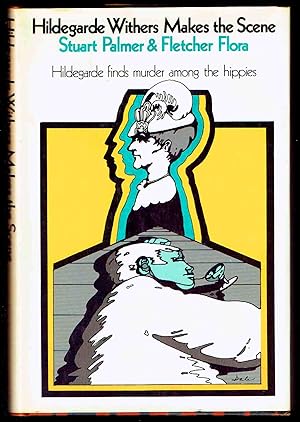
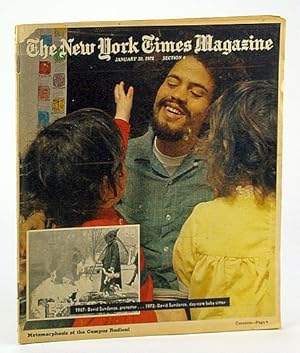
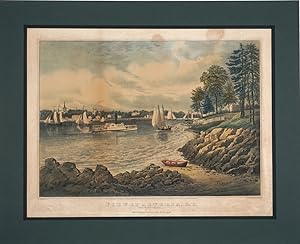
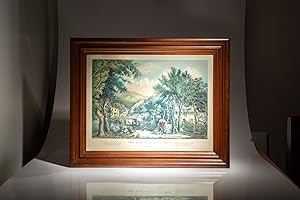
![Seller image for Love and the Flowers. [Illustrated album amicorum] for sale by Open Boat Booksellers](https://pictures.abebooks.com/inventory/md/md31517494517.jpg)
